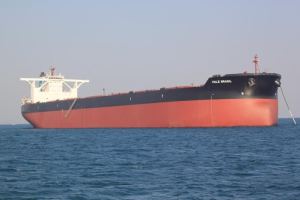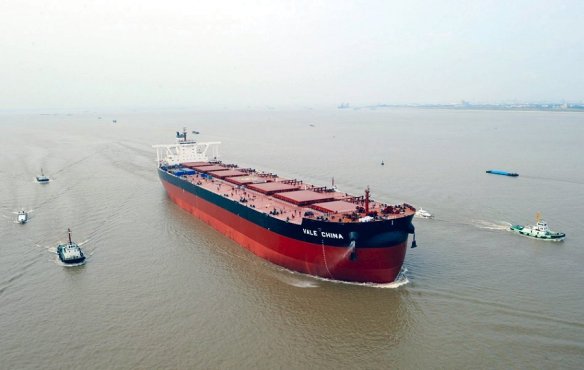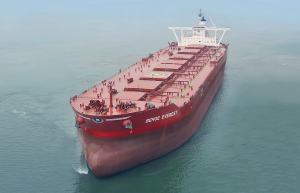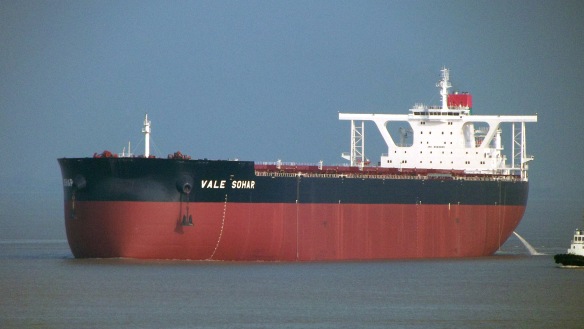In May 2008, capesize vessels – hard to believe now – were averaging $155,000 pd on the spot market, while the ‘front leg’ of the trade Tubarao (Brazil) to Qingdao (China) was earning $262,000 pd. According to published reports at that time, China’s estimated iron ore imports for that year were projected to reach 385 million tons, a 20% increase over the previous year (and having grown between 20% and 40% annually since 2001). Iron ore price on the spot market at that time was $185 per ton (vs ca $130 per ton basis annual contract price). Freight cost for iron ore was $75 per ton from Tubarao to China / Far East while the cost from West Australia to China / Japan was less than $30 ton. From Vale’s point of view, the Brazilian mining behemoth, such freight rates posed a major dilemma: buyers would not afford to pay such a high freight cost on the long term (freight at more than 50% of the commodity itself, priced on contract basis is unheard of and poor economics), and also, West Australian exporters (BHP, Rio, etc) had a very distinct advantage on freight cost, threefold to be exact.
By the way, at that time, five-year old capes were selling for $150 million, and in that month the capesize vessel MV „Bet Performer” (1997, NKK, 172,000 dwt) was sold at $130 million. The transaction was immortalized in a case study prepared by Harvard Business School a couple of years later (disclaimer: yours truly was involved in preparing the case study) focusing on how managers attempt to deal with valuation of shipping assets, and, by extrapolation, arriving at decision making.

VLOC vessel MV ‘Vale Brasil’ – The first of many!
In early August 2008 – about a month before the collapse of Lehman Brothers and the ensuing financial crisis – Vale placed an order at Jiangsu Rongsheng Heavy Industries (RSHI) in PRC for twelve 400,000 dwt Very Large Ore Carriers (VLOCs), also known a ‘Chinamax’ or ‘Valemax’ vessels depending on timing and circumstances. The order had a contract value of $1.6 billion, approximately $135 million per vessel. Almost a year later, in October 2009, Vale placed another order, initially for four and later upped to seven 400,000 dwt vessels, at Daewoo Shipbuilding & Marine Engineering (DSME) in South Korea at approximately $115 million per vessel. Vale also entered in 2009 into a 25-year charter agreement with STX PanOcean for the latter to order an additional eight Valemax vessels and charter them to the former, and likewise with Oman Shipping Company for four additional 400,000 dwt to supply Brazilian iron ore to a steel plant Vale had in the works in Oman. These four vessels with Oman Shipping were ordered and built at RSHI at a contract price of $125 million per vessel. Vale’s initial plan called for an initial fleet of 35 Valemax vessels (both owned and leased) at a total cost of $4.2 billion with a direct aim of achieving a freight cost of $17-18 per ton from Brazil to major Chinese ports. In as late as in 2012, Vale officials in an interview with the Financial Times were stating that an armada of 100 megaships would eventually be required to service the company’s 200 million per annum iron exports to Far East (one vessel, four round trips per annum, or 1.5 million tons of iron ore transported) at a competitive cost basis, sending chills through the spines of shipping executives worldwide. All vessels of the Vale armada were to have the ‘Vale’ prefix, starting from the first one delivered MV „Vale Brasil” from DSME in March 2011, although MV „Vale China”, the first one from RSHI, was the first one to be ordered and planned for delivery; she was eventually delivered in November 2011, approximately eight months after MV „Vale Brasil”.
At approximately 360 meters length (ca 1,185 ft), 23 meters (75 ft) laden draft and 65 meters beam (213 ft), Valemaxes are one of the biggest floating objects ever built. Only the poor-fated supertanker MT „Seawise Giant” at 458 meters (1,505 ft) and with 565,000 dwt built in 1979 and the modern ‘Triple E’ 18,000-TEU containerships by Maersk at 399 meters length (1,309 ft) are longer; a Valemax vessel is a shade shorter than the Empire State Building (high of 373 meters, 1,224 ft). A seven-cylinder engine with 39,000 hp output propelling the ship at 15 knots and burning 100 tons of fuel per diem, with seven cargo holds each one as big as a panamax dry bulk vessel and capable of being loaded at a loading rate of 13,500 tons per hour per cargo hold, these vessels were supposed to be a marketing coupe for Vale, a marvel of efficiencies and low emissions (per unit of cargo and distance transported) and a masterstroke against the Australian competition in terms of freight cost.

Very Large Ore Carrier (VLOC) MV ‘Vale China’ – It took a few years for the vessel name to get accepted. (Image courtesy: http://www.aukervisser.nl)
From the beginning the headaches started strong; although the original design called for 400,000 dwt, there have been reports that the first two vessels at RSHI were only 380,000 dwt since Chinese ports at the time could not accommodate larger vessels for safety reasons (commercial databases list the vessels as 400,000 dwt but databases are fed with data and have disclaimers as long as the draft of a laden VLOC itself; only the owner knows in this case). Then, there have been doubts on whether RSHI would be capable to build and deliver on time and on budget quality vessels such these, given the yard’s lack of expertise with similarly-sized tonnage. Although the yard eventually managed to deliver the vessels more or less according to contract, concerns about the safety of such big vessels calling ports (Chinese ports that is) were persistent. Such fears were not totally un-hinted or unfounded: in June 2001, „Vale Brasil” on her maiden voyage en route to China with 391,000 tons of iron ore onboard was re-routed and turned back to the Atlantic, having raised the Cape of Good Hope in South Africa, eventually discharging her cargo at the port of Taranto in Italy, at Vale’s insistence that the re-routing was due to purely commercial considerations rather than ‘signals’ she would not be allowed to dock in China. On 31 January 2012, the Ministry of Commerce of the People’s Republic of China officially banned dry bulk carriers with capacity exceeding 300,000 tons from entering Chinese ports, making the „Berge Everest” (388,000 dwt and on charter to Vale) to be the only ‘Valemax’ vessel allowed to dock in China in the interim. With the Chinese ports now closed to Vale’s ships, the company’s core strategy of lower freight cost was spinning on its head. Despite the Chinese safety concerns, Valemaxes have been allowed to call ports and discharge in the Netherlands, Oman, Japan, South Korea and at Subic Bay in the Philippines where Vale had built pre-emptively a transshipment center for iron ore. Safety concerns are always serious for new designs and vessels, especially for vessels of titanic dimensions, and when the cargo is un-forgiving: iron ore is one of the heaviest cargoes per volume unit in the world and loading at a rate of more 10,000 tons per hour per cargo hold, the stresses on the hull are monumental and it has been known to happen older capesize vessels to snap in half and sink at the dock while loading. Safety concerns seemed to gain ground in an untimely fashion for Vale, when in December 2011, five months after the diversion of „Vale Brasil” on her maiden voyage to Italy and with the „Berge Everest” about to call Dalian in China to discharge, „Vale Beijing” experienced problems with the ballast water system while loading at Ponta da Madeira Port, Brazil; concerns were very serious that there was even speculation of the ship sinking in port in laden condition, a nightmare scenario for Vale. The vessel was repaired at anchorage, then proceeded to discharge in Rotterdam, and then headed to South Korea for drydocking and repairs when it was revealed that damage was localized and that the ship (and the design) were structurally sound. Interestingly enough, „Vale Beijing” was one of the STX PanOcean vessels built in Korea at STX Shipbuilding, a yard with a record of more than 500 ships built in more than a decade with several of them being capesize and supertankers for reference account shipowners, which may be interpreted that „Vale Beijing” problems were growing pains of developing a new design rather that a material concern. The Classification Society’s (Det Norske Veritas (DNV) at the time) report after the drydock seemed to concur on the point.

VLOC MV ‘Berge Everest’ – Missing out on the claim ‘being largest ship of her time’ turned out to be a great political foresight!
With the Chinese ports closed to Valemax tonnage, Vale had been forced to explore different options. The transshipment approach, Valemax trade to the Philippines, unloading the cargo and loading it on ‘normal’ capesize vessels for final shipment to China, chipped away most of the economics of the big ship scales. Vale was forced to water down their rhetoric on the Valemax project and openly invite logistics ‘partners’ to a dialogue to meet their shipping needs (an assumption that the partner had to be Chinese likely would not had been un-reasonable). The vessels had been discussed in the market for sale & leaseback transactions on several occasions, but really were never taken seriously; it seems every shipbroker in the world had a Valemax project in his (or her) pocket pitching to financiers and any bending ear, while all along, everybody knew that this was not a financial exercise but rather of a more delicate political essence. At some point, Vale even mentioned selling the vessels outright, an implied admission that they had hit a great wall. All along, The China Shipowners Association, sensing missing a game changer with the construction of these vessels, had been putting pressure on the government to keep barring the vessels on safety concerns. China Ocean Shipping Company (COSCO), the state-owned biggest shipowner in China, ‘has safety concerns about the Valemax vessels, which are almost as big as the Bank of America Tower in New York’ according to the President of China’s Ministry of Commerce at the time, based on an article on Bloomberg.

Chinese built VLOC MV ‘Vale Sohar’ – Always smooth sailing, but never had to try her launching port!
Fast forward almost three years later, and with Vale under new leadership, there has been a watering down of the rhetoric and a slow realization that a new course of action may be required. There have been signs of thawing of the relationship between Vale and Beijing, and in May this year, the Chinese Ambassador to Brazil Li Jinzhang mentioned that ‘(they) had every interest in resolving the matter and then signing of a port cooperation deal during Chinese President Xi Jinping’s visit to Brazil during July (2015)’. The political framework also had been getting more opportune as 2014 marks the 40th anniversary of formal diplomatic relations between Beijing and Brasilia. And, COSCO having barely escaped de-listing this year due to years of chronic losses, was better prepared to accept a partial victory than a triumph. While the thawing was of glacial pace, as of last week, there have been precipitous developments whereas Vale has agreed to sell and leaseback four of its existing VLOCs to COSCO for a 25 year term, and also, for COSCO to order ten more VLOCs vessels and charter them to Vale for 25 years. Subsequently to this, it was announced that Vale has also reached a ‘framework agreement’ with China Merchants Energy Shipping (CMES) for the latter to build ten more VLOCs against Vale’s 25-year contract, similar term with COSCO and also with Oman Shipping originally when the Valemax approach first got off the drawing board. There have been no details on numbers and financials, when the new twenty VLOCs will be built (likely safe to assume in China); there has been no formal announcement of China lifting the safety ban on the rest of the Valemax armada, but reports from the front lines imply that this now would be a low hurdle to overcome, subject to good behavior.
There are a couple of lessons to be learned here; the fastest one is that in short order, just in the last two weeks, twenty VLOCs (so far) were added to the world fleet in an effort two meaningful market players to iron out their business differences; grossly, twenty VLOCs are equivalent to more than forty capesize vessels, at a time when there are more than 1,400 capesize and VLOCs on the water, with approximately 800 (57% of the world fleet) of which being newer than five years. And still, there have been 350 more on order, under construction, not counting these VLOCs. And these VLOCs with COSCO and CMES are controlled by strategic players and access to captive cargo and likely would be the first ones to be kept busy, way ahead on the chartering line from the vessels of independent shipowners (including private equity funds and publicly listed companies) piling up on them at present while salivating over the sunny days of $262,000 pd freight for the front leg of the trade. The second lesson to be learned, in a recent article in Week in China magazine, China’s approach to achieving their goal has been compared to Fabius Maximus’ ‘war of attrition’ in order to defeat Carthege’s Hannibal’s superior army. Delivering iron ore in one’s backyard for decades to come without allowing for some jobs to be created and know-how and expertise to be shared, and left-handedly excluding from the business the ‘locals’, it just seemed too lopsided; with little room to take direct action, China projected political pressure based on ‘safety grounds’, such a subjective matter that any port captain worth his (or her, seldom) salt has mastered in the first year on the job; China just took the subjectiveness to a national and the international stage. There have been reports that Vale’s (previous) leadership under-estimated the political considerations, optics and ‘soft issues’ of the transaction focusing mostly on the financial and logistical aspects, and the execution has not always been masterful; again, seeing these sale & leaseback transactions some time ago circulated in the market with such promiscuity, one had to wonder at times who was behind this strategy and the brainpower utilized to move along such a monumental project.
Probably, we now know.
© 2013-2014 Basil M Karatzas & Karatzas Marine Advisors & Co. All Rights Reserved.
IMPORTANT DISCLAIMER: Access to this blog signifies the reader’s irrevocable acceptance of this disclaimer. No part of this blog can be reproduced by any means and under any circumstances, whatsoever, in whole or in part, without proper attribution or the consent of the copyright and trademark holders of this website. Whilst every effort has been made to ensure that information here within has been received from sources believed to be reliable and such information is believed to be accurate at the time of publishing, no warranties or assurances whatsoever are made in reference to accuracy or completeness of said information, and no liability whatsoever will be accepted for taking or failing to take any action upon any information contained in any part of this website. Thank you for the consideration.













